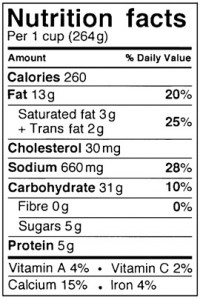Eating a healthy diet is a challenge for many Canadians. Working long hours, commuting, children’s activities, and social and family commitments can make it difficult to find the time to shop for, prepare, and eat healthy nutritious meals, leading one to eat at restaurants or choose convenient prepackaged meals that can be quickly prepared at home. Unfortunately, many of these options are unhealthy, as they contain an excessive amount of calories, salt, unhealthy fats, or are high in sugar. These unhealthy foods lead to an increased risk of many chronic diseases, including obesity, type 2 diabetes, cardiovascular disease, and cancer.
In order to choose healthy meal options it is important to know how to read/interpret nutrition labels. Interpreting nutrition labelling on packaged foods can be confusing, and many manufacturers make misleading claims regarding the health of their products. For example a popular breakfast spread claims to have “91% less sodium than the leading peanut butter” (sodium is salt). Sounds healthy, but, if you look at the label, the majority of the spread is sugar – not healthy at all.
When looking at a food label, there are several things to watch out for. Specifically, look at serving size, calories, as well as the amount of saturated and trans fat, cholesterol, sodium, and carbohydrates (total, fiber and sugar).
 Serving size
Serving size
Start by looking at serving size. Serving size allows comparison between similar products (for instance, two tortilla chips manufacturers have serving sizes of 28 vs. 50 grams of tortilla chips), enabling you to estimate your consumption of nutrients based on the amount that you eat.
Calories
A calorie is the amount of energy that comes from food. Eating foods that are high in calories can result in excess energy intake. This energy intake is stored as fat, causing obesity and increasing the risk of several chronic diseases.
Number of milligrams of nutrients vs. % Daily Value
These numbers are important as they indicate the nutrient content of the packaged food. In general, it is easier to look at % Daily Value of nutrients instead of the number of milligrams.
Fats and Cholesterol
Saturated fats and trans fats are the ‘bad fats’. Both of these types of fats, along with dietary cholesterol, increase blood cholesterol levels, which increases the risk of cardiovascular disease. If looking at a nutrition label, saturated fat and cholesterol should be less than 15% Daily Value per serving. Trans fats are a more harmful type of fat and should be avoided altogether.
Sodium
High dietary sodium intake, like fat and cholesterol, increases the risk of cardiovascular disease. In addition, high sodium diets increase risk of developing certain forms of cancer. Choose foods with less than 15% Daily Value per serving.
Carbohydrate – Fiber and Sugar
Fiber is a type of indigestible carbohydrate. It is not broken down and absorbed as a nutrient. Instead, fiber remains in the gastrointestinal tract where it helps to regulate bowel function, fat and sugar absorption, and contributes to feelings of fullness after a meal. Many Canadians do not consume enough fiber in their diets. Choose packaged products that are high in fiber.
Sugar is a soluble carbohydrate. It is naturally contained in certain foods, such as digestible parts of plants (primary source), and dairy and dairy products (low carbohydrates content). As well, it is found in foods that have been sweetened with various forms of sugar (glucose-fructose, fructose, lactose, sucrose, cane sugar, honey, molasses, corn syrup, etc). Consuming excess sugar, specifically from sweetened foods increases calorie intake without adding any other nutritional or health benefit. This may lead to obesity and other chronic diseases. Currently there is no recommended amount of sugar that is considered ‘healthy’. As a general rule, try to consume less than 100g of sugar per day (15g or 15% per serving).
Vitamin A and Vitamin C
These nutrients are abundant in a normal healthy diet and should be disregarded on a nutrient label. For instance, eating one medium sized carrot provides approximately 430% of the recommended dietary intake of the nutrient (vitamin A), so there is no need to seek it out in packaged foods.
An important note on food choices
The healthiest foods do not come with nutrition labels. These foods include fruits, vegetables, un-ground raw meat and poultry, fish and seafood. These foods generally are the healthiest and ideally should make up most of the diet.
If you have questions about your diet, nutrition label reading, proposed changes by Health Canada on nutrition labels, or how a naturopathic doctor can help you, please call 613-290-6115. Graham Beaton is a Doctor of Naturopathic Medicine in practice at Ottawa Collaborative Care Centres – 102 Lewis Street, Ottawa.
